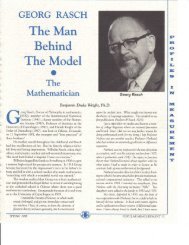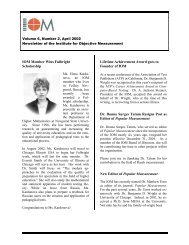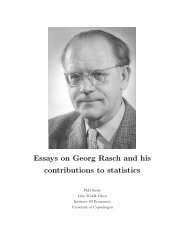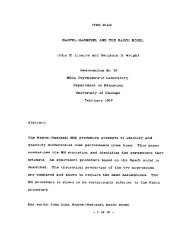Memo # 1964-2 PDF - Verio
Memo # 1964-2 PDF - Verio
Memo # 1964-2 PDF - Verio
Create successful ePaper yourself
Turn your PDF publications into a flip-book with our unique Google optimized e-Paper software.
1. Introduction.<br />
In the publication Ell a new approach to test psychology was<br />
attempted.<br />
Traditionally the properties of a test are defined in terns of<br />
variations within some specified population. In practice such<br />
populations may be selected in various reasonable ways, and<br />
accordingly the properties referred to, e.g. the reliability<br />
coefficient, are not specific to the test itself, they may vary,<br />
even considerably, with the population chosen.<br />
Similarly the evaluation of a subject usually is, by way of a<br />
standardization, linked up with some population and is therefore<br />
not specific to the subject per se.<br />
The new approach aimed at developing probabilistic models, in<br />
the application of which the populations could be ruled out. It<br />
was a discovery of some mathematical significance that such models<br />
can at all be constructed, and it seemed remarkable that data<br />
collected in test psychological routine work could be fairly well<br />
expressed in terms of such models.<br />
In the paper P.] an attempt was made to build up a general framework<br />
within which the models of Cl appeared to be special cases.<br />
And some general properties of this general framework were recognized.<br />
But 'only recently it has become quite clear, that the model<br />
(4.6) of 02.) is in fact the complete answer to the requirement<br />
that statements about the parameters of a discrete probabilistic<br />
model and about the adequacy of such a model should be objective<br />
in a sense to be fully specified.<br />
At present, at least, the theory leading to this result is rather<br />
involved and it is not going to be a main topic for this paper.<br />
However, it is intended that the following discussion of one of<br />
the models in ilj t viz. the model for item analysis in case of only<br />
2 possible answers, should demonstrate the nature of the type of<br />
objectivity we are aiming at, thus pointing to the more general<br />
problem to be treated elsewhere.<br />
2. Data.<br />
*/•..<br />
The situation to be considered is as follows:<br />
A large number of subjects (1o94 recruits of the Danish Ari.f) were<br />
exposed to an intelligence test BBP, consisting of four aut,Lests,<br />
two of which we shall deal with: N. (numerical sequences) and F.<br />
(geometrical shapes to be decomposed into some or all out of five<br />
given parts).









